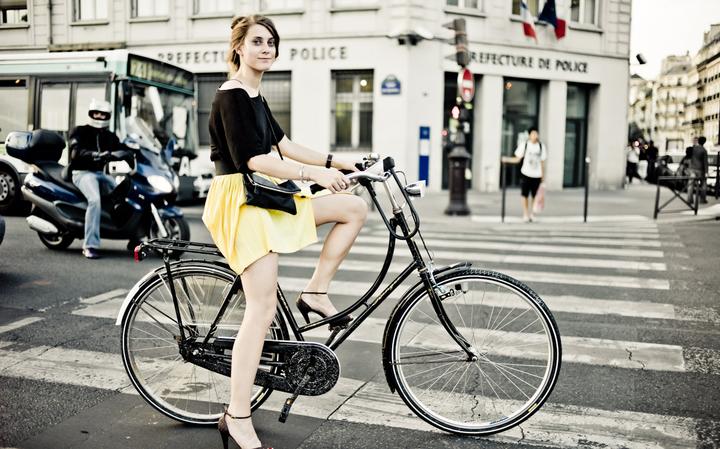Danes like to ride their bikes every day

What’s especially nice about biking in Denmark is that you are considered as a type of commuter.
A lot. Everywhere you go in Copenhagen you will see bike riders or bikes parked at random places. You will soon discover why the Danes are so fond of their bikes. A bike can take you anywhere and is often a lot faster than taking the bus. Furthermore, you will never have to worry about delayed trains and you can use the money you would have spent on the train fare on something much more delightful such as beer at Nexus on Thursday nights.
There are some unwritten rules most bikers in Copenhagen follow that will make your life easier. First of all, bikers use hand signs. The signs are easy to learn and will prevent other bikers from crashing into you. As an added bonus, people will yell at you a lot less if you learn the signs. There are 3 signs.
If you want to go left, you hold out your left hand. If you want to go right, you hold out your right hand. If you want to stop, you hold up a bent arm with your hand pointing to the sky. Of the 3 signs, the stop sign is by far the most important. A final sign for biking is the bell. While it is not strictly required, it works like a magic remote on cyclists. Ring the bell once and they form a neat orderly line to the right with plenty of space for you to pass.
Bikes also follow the same system as cars do in respect to driving on the right side of the road. If you’re biking along, you usually want to be following the same direction as traffic. This, however, is not a hard and fast rule, as sometimes you will see bikers biking against traffic. This is unadvisable except for very short distances.
What’s especially nice about biking in Denmark is that you are considered as a type of commuter. There are bike lanes along most major roads. On some of the larger paths, you will see white dotted lines running on the edge; these are passing lanes, never to be filled by someone biking slowly. When cycling, keep to the right unless you’re passing.
If there is no bicycle lane (such as in the more residential areas) keep to the road and keep right. It is generally frowned upon to go biking on the sidewalks simply because in some areas they are almost too small for pedestrians. Instead, keep to the road and be attentive of cars behind you, if you can give them enough space to pass, let them pass.
In Denmark, it is also required by law to have lights on your bike any time after dark (which means in winter, you will rapidly burn out your bike lights).
These can be picked up at most drug stores or grocery stores, just look near the bike locks and helmets. In Danish they’re called “Cykellygter” and can look similar to key chain lights, all the way up to fancy “mounted onto your frame” permanent lights.
While biking, some signs will have the word “undtaget” with a picture of a bike below a sign, this means “excluding bicycles”.
Thus, if you see a one way (ensrettet) sign with a “undtaget” sign below, bicycles are allowed on both sides. But remember, that’s just law. Some places this clearly won’t work. Use common sense and it should be alright.
Bikes also are not allowed to “turn through” intersections. If a bike wants to turn left on to a new road, they must cross in one direction first, and then cross in the other. At busier intersections, you will see many people bike halfway across and then hold up a stop hand sign. This means they probably want to turn left here and are going to sit off to the side. Occasionally, if the lights are against you, you will see people hop off their bikes and cross as a pedestrian (so they can walk left, and then walk across). This is one of the other major upsides of bicycling.
Finally, since bicycles are considered a viable mode of transport, it is illegal to ride your bicycle drunk. So if you’re going out drinking, consider an alternate mode of transport home, or just don’t drink that much before biking home.
There are also several things that are strongly recommended to do even though no one will punish you for not doing them. These are just some basic precautions to stop you from cracking your skull open on the road or having your bike stolen (a common problem in Copenhagen). While it may look ridiculous, it is a good idea to wear a biking helmet. They are available in a wide range of colors and shapes. They range from neutral black helmets to very colorful helmets in funky shapes. That said, there is no law requiring a helmet in Denmark. Many of the riders may simply not have grown up with it, and it hasn’t really been part of the culture here in Denmark. Unless you come from a country where you can bike alongside major highways and not flinch, start out with a helmet and see how it goes from there.
Another very necessary thing is to remember to lock your bike. It sounds obvious, but a lot of bikes are stolen every week in Copenhagen. If you want to be sure that your bike is there when you return, you may want to purchase a chain lock.
Chain locks have the obvious advantage that they can chain your bike to the bike stands. Lastly, it is a great idea to stick to the bike parking zones and respect “no bike parking” signs, as you might otherwise end up having your bike picked up by the police. If you are in the market to buy a bike.